The Anole Lizard, Chameleons and Other Woodland Lizard Species
Owning a pet Chameleon, anole lizard, geckos and other woodland and forest species is accomplished by creating a terrarium replicates at tropical or rain forest. Specific recommendations are described below. In general, preferred terrarium substrates is a layer of gravel covered by the material used by an air conditioning filter. Cover this with 2 to 3 inches of soil. The terrarium can be decorated with twigs and branches. Use a plastic or glass top to hold moisture in the tank. To reduce humidity levels, use a screen for the tank top.
Lizards found in Woodlands and the Forest:
Types of Woodland and Forest Lizards as Pets:- Anole
Lizard Species: Lizards from this
family are found all over the world, with lizards in the wild spread
through escaped pets. The species can be as small as a few inches in
length to larger members of this family that can grow as large as 18
inches. The North American Green Anole is well known for its' color
shifting abilities. Terrarium should resemble a dry woodland. All
Anoles can shift color, which is caused by shifting pigments related to
stress. Cages with more than one lizard should be at least 4 feet
x 5 feet.
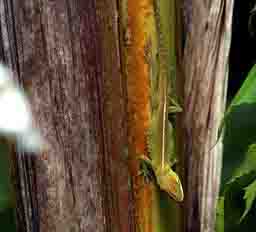
Picture of Anole Lizard blending in to leaf
Source: Brocken Inaglory
- Knight Anole Lizard: This Anole Lizard can grow to 15 inches to 18 inches. In the U.S. it is found in Florida.
- Diet is comprised of berries, fruit, tree frogs, other
lizards, insects
- Brown Anole Lizard: This type of anole is seen in pet stores. They grow to 8.5 inches in length.
- Easy to keep as a pet lizard
- Require a humid environment
- Terrarium should be 20 gallons for a small lizard to larger than 50 gallons depending on the size of the Brown Anole.
- Good lighting with heat lamps directed at a vertical and
horizontal resting area are required
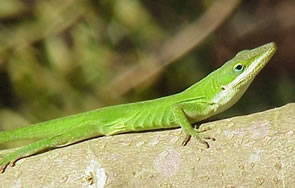
Green Anole Lizard (Also known as the American Chameleon)
Source: Herp of NC
- Chameleons:
Flap Necked,
Senegal and Graceful chameleons are often trapped and kept by
hobbyists. These lizards are not easy to maintain in captivity
and are therefore not recommended to pet owners. Few live more than a
few months in captivity due to the level of care required to keep them
healthy. Do not purchase a Chameleon that was captured from the wild
(often cost less than $50), since the stress will probably result in a
decline in health. Instead, spread approximately $100 and get a
Chameleon that was bred in captivity. Chameleons become stressed
when handled. Many amateur hobbyists should avoid this pet lizard
since they are delicate and can be hard to handle.

Chameleon from Central Kenya, Probably a Chamaeleo hoehneli
Source: Eysteinn Guoni Guonason
A preferred pet chameleon for home care include the Four-horned and Mountain Chameleons. To determine if a Chameleon is healthy when purchased check the weight, color and eyes. Any encrustations around the eyes can signal a potential health problem or a stressed animal caused by captivity or shipping.
- Chameleons need to be kept in very large areas (4 ft x 30
inches wide. The lizard cage should be wire mesh and offer
sufficient vertical space. The terrarium should be well ventilated and
filled with limbs, trunks and plants such as potted hibiscus or Ficus
benjamina.
- Feed a variety of insects, not just one. These include butter worms, wild insects and meal worms, Some will eat greens, blossoms and vegetables.
- Chameleons will only drink droplets of water on plants or a
dish that is aerated by a pump.
- Indoor pet chameleons require calcium supplements.
- Veiled Chameleons: These chameleons can grow to two feet in
length, Cage high temperature should be 70F. This omnivore likes to eat
leaves from Romaine, Escarole, Hibiscus, Nasturtium, Ficus benjamina,
Syngonium, Epipremnum.
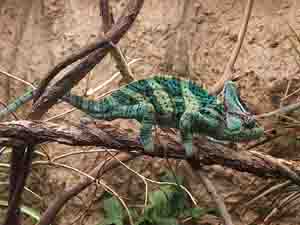
Veiled Chameleon
Source: Steven G. Johnson
- Panther Chameleon: Male panther chameleons can grow to 20
inches. Colors are turquoise or green banded.
- Jacksons Chameleon: Males grow to 14 inches. Thrive in
daytime temperatures that are 74F to 78F (23-25.6C) and night
temperatures at 50F to 60F (13.9-17C).
- Four Horned and Mountain Chameleons: These chameleons are one
foot in length and are characterized by the appearance of a horn on
the head, Requires night temperatures at 50F and day temperatures at
mid 70's (21-23.9C)
For more information download the Chameleon Owners Manual here (free PDF Download by Noelle Senchyna)
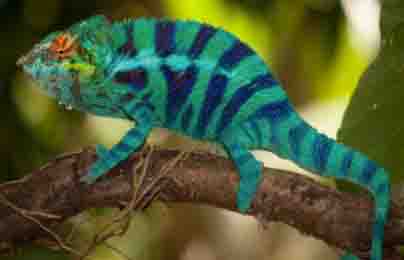
Chameleon Woodland Lizard
Source: SuperTeacherWorksheets
- Chameleons need to be kept in very large areas (4 ft x 30
inches wide. The lizard cage should be wire mesh and offer
sufficient vertical space. The terrarium should be well ventilated and
filled with limbs, trunks and plants such as potted hibiscus or Ficus
benjamina.
- Day
Geckos: There are 25
of 60 species sold as pet Geckos. These species are both caught
in the wild, or preferably bred in captivity for pet stores. With some
exceptions, it is not a good idea to place males of different species
in the same terrarium. When in captivity, Geckos act in ways that are
similar to packs of dogs, with a hierarchy quickly established.
If you notice that one of your Geckos kept in a group has an abnormal
color, this could mean that the Gecko is stressed and not eating.
If this is the case the pet Gecko should be removed from the cage.
They are active during the day and at night. They are native to Madagascar, Seychelles and the Comoros. Gold Dust Day Geckos have also established themselves in Hawaii and Florida, They are easy to breed and care for in captivity.
- Appearance: Round pupils, Greenish color, expanded toe tips,
lidless eyes
- Size: Varies by type. The Neon Day Gecko is 3 inches. Standings Day Gecko is 12 inches.
- Male Geckos have a budge at the tail base and female geckos
have pores that continue with no interruption to the tail.
- Gecko Diet: Geckos eat insects such as crickets, saps juices,
overripe fruits nectar, pollen, overripe fruits. Insects should be
dusted with vitamins. Water is consumed from droplets on plants.
No matter what lighting or diet is being used, use vitamin supplements
that provide vitamin D3 and Calcium. Mist plants daily to provide
the needed water droplets.
The book Lizard Care A to Z recommends the following home made Gecko food: Gecko diet should be left on a log in the cage:
- 1/3 jar of mixed fruit or apricot strained baby food
- 1/2 jar of strained papaya baby food
- 1 teaspoon honey
- 1/3 eyedropper of Avitron liquid bird vitamins
- 1/2 teaspoon of Osteoform powdered vitamins
- Plus water to preferred consistency
- Gecko Cages: Most Geckos require a Woodland/Tropical
terrarium
such as those offered by Zoo Med. Purchase a "tall" tank that is
at least 15 gallons if 2 to 3 small Geckos are kept as pets. Multiple
larger Geckos require a 30
Gallon Reptile Tank (114L, 16x16x30 in inches) to 80
(189-303L) gallon tank such as this 50 gallon tank (18x18x36 from Reptimed).
- Substrates: 4 inches of sterilized potting soil
- Decorations/Climbing: Decorate with items such as cork bark
tubes and hollow logs.
- Lighting: The terrarium can be lit with both a
fluorescent bulb and a a flood light that encourages plant
growth. Use lights to warm one or two areas for basking in the
heat/light. Geckos like to bask on bamboo. Use a aquarium sealant
to attach an end of the bamboo to the side of the Gecko cage.
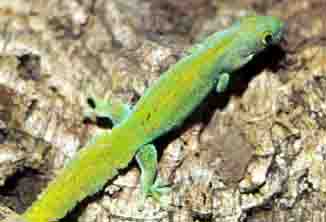
Day Gecko Woodland Lizard
Source: Petco
- Emerald
Tree Monitors: The most popular Emerald Tree Monitor
is the emerald colored V. prasinus. The lizard is from Papua/New
Guinea. The lizard grows to a maximum length of 30 inches (75 cm). Be
careful when handling this lizard since it has sharp claws and a strong
jaw. Over time the lizard will get used to your handling.
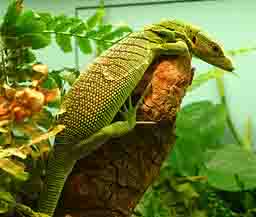
Emerald Monitor Lizard
Source: Wikimedia, Tim Vickers
- A large cage is needed for Emerald Tree Monitors. These
lizards eat a diet that includes crickets, grasshoppers, June beetles,
king mealworms and baby mice. They will also eat lean beef, slugs and
canned cat food.
- Daytime terrarium temperatures must be between 84 to 92 F
(28.9 - 33C). Humidity needs to be kept at 75?. At night, the
terrarium temperature should be between 68 to 75 F (20 to 24C). Include
a basing area of 95 to 98 F (35-36.7C).
- The terrarium should be tall and include limbs for climbing.
Include hiding places for the Emerald Tree Monitor to hide.
- Health issues such as endoparasites can be a problem. A
veterinarian can test feces samples for the parasites.
Have a Lizard Related Question for our Vet? We Will Answer it for Free!
Do you need some pet lizard advice? Just ask a question and our Vet will answer it as soon as possible.
If your question is medical or behavior-related, please include information such as species, age, diet, habitat, and anything related to the medical history of your lizard.
Please upload a picture of your lizard, especially if you believe it will help the Veterinarian. Please know that we receive many questions and answer them on a first-come, first-served basis. If you need an immediate response, we suggest you use this online veterinary service that is available now to answer your questions.
Other questions answered by our Veterinarian
Click below to see questions from other visitors to this page...
Are Green Anole Known to Behave Aggressively Towards Others in their Tank? Not rated yet
Asking for another person.. 2 small green Anoles in terrarium tank. One got aggressive. Did not allow 2nd to eat. 2nd either died or was killed by 1st …
References for the Anole Lizard and Woodland Lizards:
Lizard Care from A to Z
Leopard Gecko
Merck Manual for Pet Health
Lizards of North Carolina
Related articles on the Anole Lizard and other Woodland, Savanna,
Tropical and SemiAquatic Lizards:
How
to Select Lizard Aquariums and Cages
Signs of
Lizard
Diseases and other Health Concerns
Desert
Lizards
as Pets
Water
Lizards as Pets
Savanna
Lizards as Pets
Comments
Have your say about what you just read! Leave me a comment in the box below.